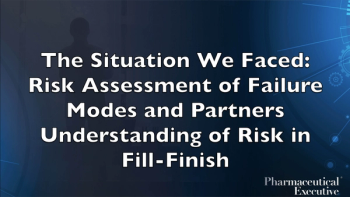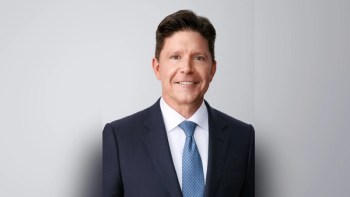
- Pharmaceutical Executive-03-01-2019
- Volume 39
- Issue 3
John Crowley: Living the Mission
Amicus Therapeutics CEO John Crowley, whose biotech journey and quest to cure two of his kids of a rare genetic disease is well chronicled, discusses the growing role of the patient-centered view in company culture-not just in adding “deeper meaning” to drug development, but in building patient advocacy into everyday business practice and strategy.
Pharm Exec interviews Amicus Therapeutics CEO John Crowley, the well-chronicled biotech executive famous for his quest to cure two of his children of Pompe disease, a rare genetic disorder. Here, Crowley discusses the growing role of the patient-centered view in company culture-not just in adding “deeper meaning” to drug development, but in building patient advocacy into everyday business practice and strategy
In 1998, John Crowley, chairman and CEO of Amicus Therapeutics, was one year out of business school, in a management consulting position on the West Coast, with a pile of student loans and three young children, when his two youngest children were diagnosed with a rare genetic disorder known as Pompe disease. The
condition occurs when there is not enough or any of the enzyme alpha-glucosidase, which breaks down complex sugars in the body. Without the enzyme, sugars build up in the muscles, causing them to break down.
Crowley’s life in biotech is well documented in articles; television appearances; books, including
PE: Your first job in pharma was with Bristol-Myers Squibb. How did that experience affect your future path as a biotech entrepreneur?
CROWLEY: I was a year out of business school and working at a consulting firm and just trying to keep my head above water on the student loans. I went to BMS because we were living on the West Coast at the time, and we wanted to be back East to be close to family, expert doctors, and a job with a company that had good benefits. BMS happened to be the right opportunity. I never went into this thinking, “I’ll do this for a year or two, learn everything I can and go start my own company.” That just evolved two years later, when we became frustrated with the pace of development, and time was as much the enemy as nature-Âand the mistakes of nature.
My first job [in pharma] was a director of area marketing position for the neuroscience and infectious disease franchise for BMS. Then I was director of business strategy for the US pharma business. Those were my two primary roles there and they had absolutely nothing to do with how to run a biotech company.
PE: Coming from your management consulting position, what were your initial thoughts around the pharmaceutical industry?
CROWLEY: It really was a whole new world. I remember going to a meeting at BMS my second day on the job and hearing all these acronyms and the different way people spoke. On the one hand it was exciting, but it was also overwhelming because I was not trained in any science background. I thought I would just be the “business guy” doing marketing plans. I realized pretty quickly that I needed to understand the biology and the science. And in this case initially, it was neuroscience medicine.
PE: It is a more common practice now for pharma professionals to go to biotech, but you made that switch 20 years ago when it wasn’t as common. What do you remember most about being in a startup environment and how that was different from traditional pharma?
CROWLEY: I had a very sharp break from pharma to biotech. I went from one of the most established, well-respected and well-run pharmaceutical companies in the world, with an incredibly deep bench, to literally starting what was then a four-person biotechnology company (Novazyme Pharmaceuticals) based in Oklahoma City that didn’t even have science data in animals; we didn’t have preclinical data. It was as startup as you can get. We didn’t have offices, we didn’t have a bank account.
I didn’t go right out to the Novazyme lab space in Oklahoma, I went to the BIO Convention. This was when the whole genomics phase of biotech was in full swing, the height of the market, and, arguably, the first bubble in biotech. I remember going to that convention, there must have been 15,000-plus people, and it was vastly different from anything I had seen in my pharma experience, which was much more structured, much more controlled.
But in biotech, there was a palpable sense of excitement around the science and the medicine. We really felt then we were just beginning the golden age of medicine with the human genome being decoded, with people increasingly understanding genomics and proteins.
I remember going to the keynote address that was given by Christopher Reeve. He came out on the stage and he was ventilator-dependent and quadriplegic, and the first words he said in that speech were, “Biotechnology. It’s a great big word that for people like me just means hope. It’s hope that one day there will be a treatment for paralysis and I can walk down the beach and hold my wife’s hand again or throw a ball to my kids. But it’s also hope for people who don’t know that they need hope today. It’s the kid that’s going to break his neck in a game next week. And his whole life in an instant and his family’s and his community’s will change.”
For me, this was an incredibly exciting time to come into biotechnology.
PE: Can you elaborate on your experiences with researchers and the science over the years? We see that researchers don’t always meet with the patients who have the disease they are studying, and they also meet with a lot of failures.
CROWLEY: I felt it was incredibly important that the people that worked at Novazyme, and also at Genzyme (which acquired Novazyme in 2001) and now at Amicus, understand what it’s like to live with a disease, and understand a family’s journey. I went to our science founder in our company those first couple of weeks and I said I want to bring in some families to talk to the employees; we were hiring a lot of young scientists at Oklahoma City at the time, and he agreed. I wanted to bring in a Pompe family, where we were focused, and we found one young lady, but she was too sick to come in at the time. So we found a family with two boys who had mucopolysaccharide II (MPS II) disease and had them come; it was eye-opening. Dr. Hung Do was the first scientist I hired at Novazyme, and is now chief science officer at Amicus; when I hired [Hung] he was right out of his post-doc, with a PhD in glycobiology, had studied at the world’s best universities, but had never met a patient living with any of these diseases until that day. It really changed his perspective.
It’s a tough balance. We’ve now done this well over a hundred times at Amicus, and have families come in and describe their journey. We do these as monthly lunch-and-learns here at Amicus, and we did them weekly at Novazyme and at Genzyme.They are emotional, educational, and inspiring. And they are a two-way street. Principally, it is for our company and our employees to provide them deeper meaning to the work they are doing and also put that work into context. And for them to derive some level of inspiration to work maybe a little more creatively or a little harder on those tough days when you face setbacks.
But for the families coming in, we provide some tangible experience on what it takes to develop medicines. We give them tours of our labs, and we sit down with them in roundtables. Some of them are incredibly knowledgeable and are already running their own foundations or organizations, and others are new to these discussions. We gear the discussions toward however helpful it is for the families. These have been among the most powerful experiences in business, and in life.
PE: You have clearly incorporated the patient into your company’s culture long before patient centricity or patient engagement became the movement it is now. What is your philosophy around working with patients and patient advocacy groups and how do you build that into your company?
CROWLEY: Working with patient organizations and working closely with patient families, it’s the right thing to do and I think it provides deeper meaning to our work. But it’s also going to make Amicus a better company. I have always believed that to have that patient-centered view, you need to build it into every aspect of your business and your decision-making. If you do that, it will become a strategic advantage and you will make better medicines and get them to more people more quickly, which is fundamentally how we build businesses in biotechnology and in pharmaceuticals.
It’s one thing to say you are patient centric, but how do you actually live it? We, early on, built a team of patient advocates. Jayne Gershkowitz (chief patient advocate, Amicus) was one of my first hires into the company because I knew she had the experience and perspective and passion to make us a better organization and to build that patient advocacy function (read more
For us, being patient centric means having a chief patient advocate, a C-suite level executive who reports directly to me and who sits on the senior leadership team and is involved in every aspect of the business. It is having patient advisory boards, and we have done this since day one; we have a scientific advisory board and medical advisory board for every disease we work in. But for every disease, we also have the patient advisory board-patients living with the disease or a parent of children living with the disease-and we meet them each a couple of times a year. They are under confidentiality agreements, we don’t pay them, but we share with them all of our confidential plans, programs, and data.
For example, when we went into preparing to enter the clinic with our new experimental medicine for Pompe disease, we first vetted all of the protocols for that study with the patient advisory board, then we
took it to the medical advisory board, and then took it back to the patient advisory board.
It’s easy to say you’re patient centric when things are going well; it’s most challenging when things aren’t going well. We had a program we were developing for the worst genetic disease I’ve ever seen, a rare skin disease called epidermolysis bullosa (EB), where because of a genetic defect, the outer layer of the skin can’t bind to the lower level, and it affects mainly children. It’s just horrible. It’s like living with third-degree burns your whole life.
The early clinical results were incredibly promising for the medicine we were developing, but in the fall of 2017, we unveiled the Phase III pivotal results, and it failed. It was not significantly different from placebo. By that point, Amicus had evolved. We had a great pipeline of medicines, a great team, and a lot of capital, so the company would survive the financial impact. But we came back to the company and had an all-employee meeting, which was probably the most emotional meeting we’ve had. Not because anybody was worried about Amicus; Amicus was going to be fine. But they worried about those kids living with the disease. I told the employees, I’m glad we did this program; I feel terrible that it failed, but we would rather be the first to fail than the last to succeed.
We regrouped and Jayne led the effort around how we can still help the EB patient community. One of the first things we did was reach out to a group of small entrepreneurial companies to share with them the data, all the clinical records and regulatory exchanges from the research process. We then met with the FDA to share everything we learned. The FDA actually held a patient-focused drug development forum six months later and changed the entire paradigm of development for drugs in that disease. A lot of actions we took after the failure were to make sure we never forgot the needs of that patient community. That program was part of the fabric of Amicus and always will be.
PE: What types of professionals do you like to hire and surround yourself with?
CROWLEY: That’s simple. At Amicus, we hire passionate entrepreneurs. Those two words capture the people we seek to attract and develop as part of our team, part of our family. The passion part-they have to embrace this patient-centered focus. They have to embrace the emotional aspects of what we do. And, again, not everybody wants to do that, but that to me is an essential element. They have to be mission-focused.
The second part is they have to be entrepreneurs. We are now a 600-person company, we aren’t that small anymore. But I still want entrepreneurs to work here. When, God-willing, we are a 1,000 or 2,000-person company, I still want entrepreneurs-people who thrive in an uncertain environment, who roll up their sleeves and take responsibility for their direct work, who think differently.
This is a tough industry. No matter what we do-we can hire Nobel laureates, build the most magnificent research and manufacturing centers, invest hundreds of millions of dollars into science, and still almost everything we try, technically, doesn’t work. But when it does work, I still think it’s the best job you can have.
Lisa Henderson is Pharm Exec’s Editor-in-Chief. She can be reached at l
Articles in this issue
over 6 years ago
Patient Advocacy: The Corporate Mandateover 6 years ago
Patient Support Programs: Cost, Benefit, and Resourcingover 6 years ago
Patients is a Virtueover 6 years ago
What Does Patient Centricity Look Like?over 6 years ago
Research Bonds Strengthenalmost 7 years ago
Parallel Trade a Victim of Brexit Collateral Damagealmost 7 years ago
Multiple Pharma Issues Top Congressional Agendaalmost 7 years ago
Pharm Exec Joins MJH Portfolioalmost 7 years ago
Cystic Fibrosis: The Importance of Patient Advocacyalmost 7 years ago
Pinpointing Performance of Key Access ActivitiesNewsletter
Lead with insight with the Pharmaceutical Executive newsletter, featuring strategic analysis, leadership trends, and market intelligence for biopharma decision-makers.





